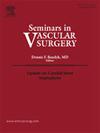Management and Outcomes of Renal Artery Aneurysms in Older Adults
IF 2.4
3区 医学
Q1 PERIPHERAL VASCULAR DISEASE
引用次数: 0
Abstract
Renal artery aneurysms (RAAs) are rare but clinically significant vascular abnormalities. The management of RAA in older adults poses unique challenges related to their baseline comorbidities and age-related vascular changes. Traditionally, open surgery has been the gold standard for large or complex RAA. However, recent data and guidelines support a more conservative threshold for intervention and broader adoption of endovascular therapies, which offer lower perioperative morbidity, shorter hospital stays, and overall faster recovery. General indications for repair include symptomatic aneurysms, medically refractory hypertension, and lesions ≥3 cm. Medical management and surveillance are appropriate for asymptomatic patients with stable aneurysms < 3 cm, especially for those with limited life expectancy. Open surgical techniques include both in situ and ex vivo reconstructions with demonstrated long-term durability but are associated with higher perioperative risk. Endovascular techniques, including coil embolization and stent grafting, are increasingly being used in anatomically suitable patients with high success. Postoperative outcomes suggest comparable long-term results between open and endovascular approaches. However, endovascular repair is associated with fewer complications and is increasingly preferred in elderly or high-risk populations. An individualized approach is essential to optimize outcomes, balancing the risks of intervention with the natural history of the disease. This is a review of the epidemiology, diagnosis, management, and outcomes of RAAs in older adults.
老年人肾动脉瘤的治疗和预后
肾动脉动脉瘤(RAAs)是一种罕见但临床上重要的血管异常。老年人RAA的管理面临着与基线合并症和年龄相关血管改变相关的独特挑战。传统上,开放手术一直是大型或复杂RAA的金标准。然而,最近的数据和指南支持更保守的干预阈值和更广泛地采用血管内治疗,其围手术期发病率更低,住院时间更短,总体上恢复更快。修复的一般适应症包括有症状的动脉瘤,医学上难治性高血压,病变≥3cm。对于无症状的3cm稳定型动脉瘤患者,特别是预期寿命有限的患者,应进行适当的医疗管理和监测。开放手术技术包括原位和体外重建,具有长期耐用性,但围手术期风险较高。血管内技术,包括线圈栓塞和支架移植,越来越多地被用于解剖学上合适的患者,并取得了很高的成功。术后结果表明,开放入路和血管内入路的长期结果相当。然而,血管内修复术并发症较少,在老年人或高危人群中越来越受欢迎。个性化的方法对于优化结果至关重要,可以平衡干预的风险和疾病的自然史。本文综述了老年人RAAs的流行病学、诊断、治疗和预后。
本文章由计算机程序翻译,如有差异,请以英文原文为准。
求助全文
约1分钟内获得全文
求助全文
来源期刊
CiteScore
3.50
自引率
4.00%
发文量
54
审稿时长
50 days
期刊介绍:
Each issue of Seminars in Vascular Surgery examines the latest thinking on a particular clinical problem and features new diagnostic and operative techniques. The journal allows practitioners to expand their capabilities and to keep pace with the most rapidly evolving areas of surgery.

 求助内容:
求助内容: 应助结果提醒方式:
应助结果提醒方式:


